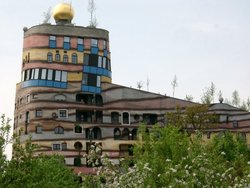Friedensreich Hundertwasser
|
|
100wass.jpg
Friedensreich Hundertwasser
Friedensreich Hundertwasser, born Friedrich Stowasser (December 15 1928, Vienna - February 19, 2000, on board the Queen Elizabeth II near New Zealand), was an Austrian artist and architect.
Hundertwasser's original, unruly, sometimes shocking artistic vision expressed itself in pictoral art, architecture, environmentalism, philosophy, stamp and flag design, and clothing design (among other areas). The common thread is a rejection of the straight line, bright colours, organic forms, a reconciliation of humans with nature, and a strong individualism. He remains sui generis, although his architectural work is comparable to Antoni Gaudi in its biomorphic forms and use of tile.
His only formal artistic training was a three-month stint at the Akademie der bildenden Künste in Vienna in 1948. His adopted surname is based on the translation of "Sto" (the Czech word for "hundred") into German. The name "Friedensreich" has a double meaning as "Peaceland" or "Peacerich" (in the sense of 'peaceful').
Although Hundertwasser first achieved notoriety for his boldly-colored paintings, he is more widely renowned today for his revolutionary architectural designs, which incorporate natural features of the landscape, and use of irregular forms in his building design. This is a rebellion against what he saw as the oppressive inhumanity of straight lines. Hundertwasser Haus, a low-income apartment block in Vienna, features undulating floors ("an uneven floor is a melody to the feet"), a roof covered with earth and grass, and large trees growing from inside the rooms, with limbs extending from windows. He took no payment for the design of Hundertwasser Haus, declaring that it was worth it, to "prevent something ugly from going up in its place".
He felt that standard architecture could not be called art, and declared that the design of any building should be influenced by the aesthetics of its eventual tenants.
Hundertwasser-darmstadt_front_750px.jpg
In 1972 he published the manifest Your window right - your tree duty : "A person in a rented apartment must be able to lean out of his window and scrape off the masonry within arm's reach. And he must be allowed to take a long brush and paint everything outside within arm's reach. So that it will be visible from afar to everyone in the street that someone lives there who is different from the imprisoned, enslaved, standardised man who lives next door". Also planting trees in an urban environments was to become obligatory: "If man walks in nature's midst, then he is nature's guest and must learn to behave as a well-brought-up guest."
His work has been used for flags, stamps, coins, posters, schools, churches, a rest area in his adopted home of New Zealand, and apartment buildings. His most famous flag is the Koru Flag; he has also designed stamps for the Cape Verde islands and for the UN post administration in Geneva on the occasion of the 35th anniversary of the Universal Declaration of Human Rights.
Hundertwasser-darmstadt.jpg
Buildings
- District Heating Plant Spittelau, Vienna
- Hundertwasser House, Vienna
- Hundertwasserhaus Waldspirale Darmstadt
- Kindergarten Heddernheim, Frankfurt
- Motorway Restaurant, Bad Fischau, Austria
- Hot Springs Village, Blumau, Styria
- Hundertwasserkirche, Baernbach, Styria
- Quixote Winery, Napa Valley, (USA), 1992-1999 (his only building in the US)
- Maishima Incineration Plant, Osaka (Japan), 1997-2000
- Public toilet, Kawakawa (NZ), 1999
- Hundertwasser "environmental railway station", Uelzen, 1999-2001
Bad_Blumau_Panorama.jpg
See also
External link
Template:Wikiquote Template:Commons
fr:Friedensreich Hundertwasser ja:フリーデンスライヒ・フンダートヴァッサー nl:Friedensreich Hundertwasser no:Friedensreich Hundertwasser pl:Friedensreich Hundertwasser ro:Friedensreich Hundertwasser ru:Хундертвассер, Фриденсрайх sv:Friedensreich Hundertwasser

